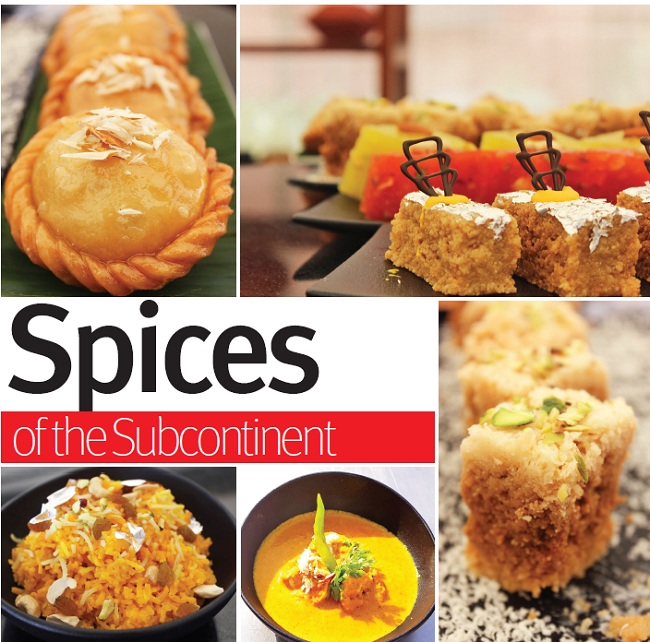From a subcontinent that is so varied in language one would expect nothing less from its food either. Indian cuisine encompasses a wide variety of dishes that are as variant and influenced by its people, terrain, climate, soil and culture.

To add to this melting pot, India was occupied at some time or another by so many invaders who not only infused their heritage with ours but also brought with them their ingredients. Hence Indian cuisine is still evolving as a result of the nation's cultural interactions with other societies. Historical incidents, not just the invasions, but also trade relations, and colonialism have played a role in introducing certain food to the country. The humble potato, a staple in many regions of India was brought to this land by the Portuguese. They also introduced chillies, which we take for granted as having always existed in India and is now such an integral part of our everyday cooking. Spices were bought from India and traded all around Europe and Asia. Indian cuisine has influenced other cuisines across the world, especially those from the Middle East, North Africa, Southeast Asia, the British Isles and even the Caribbean. It is with this diversity in mind that The Goa Marriott Resort take our taste buds on a culinary journey.
This monsoon the Waterfront Terrace & Bar, an all-day dining multi-cuisine restaurant at the Marriot showcases a plethora of flavours from all round the Indian subcontinent, crafted to tantalize the taste buds of every guest with their Culinary Journey of India festival. Offering ten days of sumptuous buffets, thrilling live stations and three resplendent brunches this festival is worth a visit. Furthermore, playing to the strengths of their various chefs, the Marriott has created a state by state journey. Punjabi dishes were showcased on August 11, Tamil Nadu on August 12 while there will be a Rajasthani brunch and dinner on August 13. They will showcase Goan cuisine on August 14, Hyderabadi style brunch and dinner on August 15, kebabs and chaats from all over India on August 16, Awadhi style of cooking on August 17, Peshwari (Maharashtrian) cuisine on August 18, Bengali on August 19 and last by not least their finale brunch on August 20.
Most of us are familiar with at least one dish from most of the regions showcased but what really catches one attention is the Awadhi cuisine, a cuisine native to the city of Lucknow, Uttar Pradesh. The cooking techniques of Lucknow are similar to those of Central Asia and Middle East with the cuisine comprising of both vegetarian and non-vegetarian dishes. The Awadh region has been greatly influenced by Mughal cooking techniques, and the cuisine of Lucknow bears similarities to those of Central Asia, Kashmir, Punjab and Hyderabad. The Galouti Kebab, a popular dish from this area was just divine with a melted in mouth experience, as the lamb was tender and perfectly minced and combined with explosive spice. However, what came as a surprise was the Khoya Kubani Ke Kofte. On first sight, this dish is unassuming but the aromas that flowed from the bowl to one's nose were compelling. Succulent apricot and condensed milk dumplings simmered in a silky cashew nut and melon seed gravy brought the opulence of a by gone era to back to life.
Another unusual sight on the menu was the Arcot Mutton Chop. The Mudaliar community from the Arcot district of Tamil Nadu have a long and delicious culinary tradition. These simple and humble chops are part of their varied repertoire and really pack a punch. These baby lamb chops were coated with green chillies, coriander and mint blend and then cooked till tender and almost falling off the bone. For those that love seafood the chefs at Marriott did not disappoint, the Prawn Koliwadi had that perfect balance of crunch with a juice and tender prawn fried with gram flour and chilli powder. The Punjabi dish of Ambarsari Rawa Macchi where the fish is simmered with onion, tomatoes and chilles, then finished in a pan with dash of lemon and coriander had that perfect balance of sweet, sour and crisp.
Moving onto to Rajasthan which was heavily influenced by the Rajput's who were or rather are predominantly non-vegetarians. Their diets often consisted of game meat which led to dishes like the famous laal maas. Rajasthani cooking in general has its own unique flavour where the simplest and the most basic of ingredients go into the preparation of delicious dishes. What is unusual is that the chefs at the Marriott have chosen to go a different route and showcase a vegetarian dish called the Gatta Curry. Comprising of gram flour dumplings flavoured with dry coriander and mustard and then steamed till tender, these are then submerged in a spicy yoghurt gravy. The simplicity of this dish is what gives way to complicated flavours and one has to go back for yet another bite.
No meal is complete without catering to that sweet tooth. The chef, they simply call "Maraj" has really out done himself with the sheer delight of dishes to quench the longing for something sweet. The Seradura, a native to Goa with that Portuguese influence was creamy and topped off with Goan biscuit and cashews. One must encompass a bit of everything on the spoon to understand the entirety of this combination. The Ghevar, which is crispy gram flour discs dunked in sugar syrup and condensed milk and then adorned with silver leave was a true jewel that really stood out from the rest of deserts. All in all this festival really is a whirlwind of everything Indian and everything that is great about this nation.
(Dylan Katie Rockcliffe believes that eating is a necessity and food is essential to live but cooking is an art form, so what better way to explore life then through all the culinary delights it has to offer.)